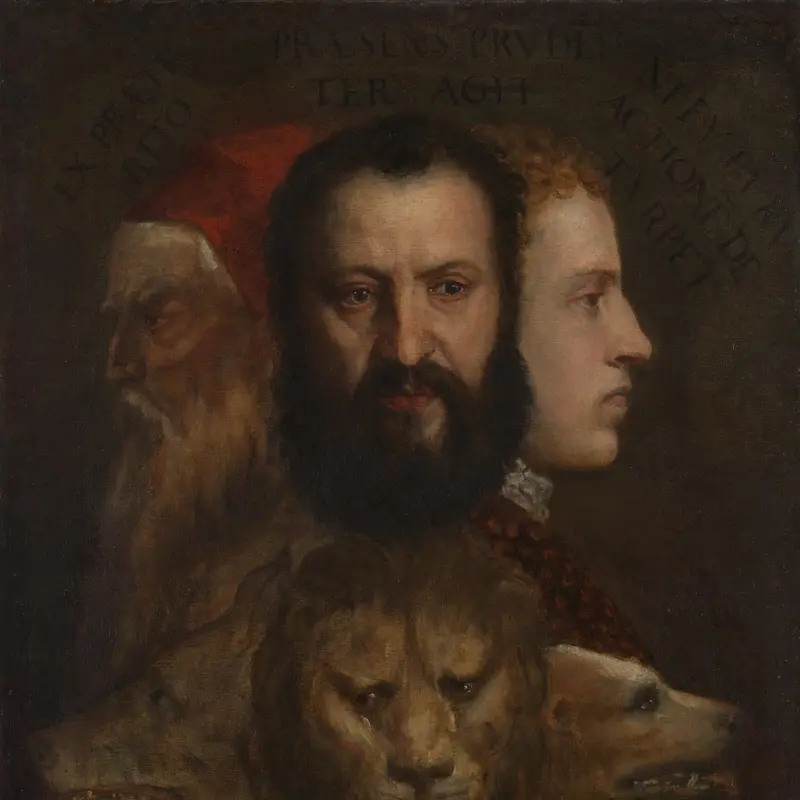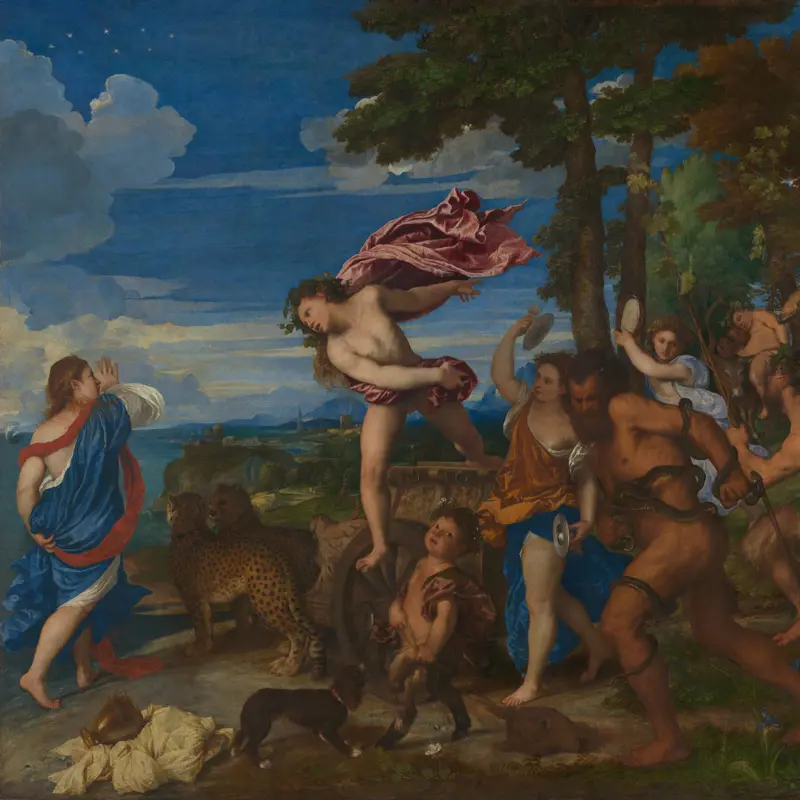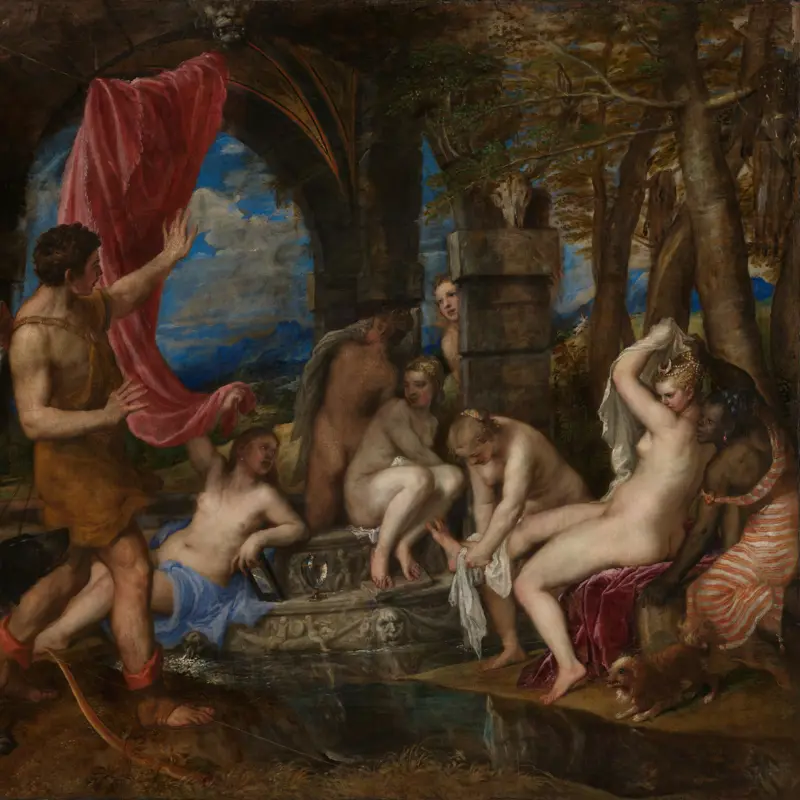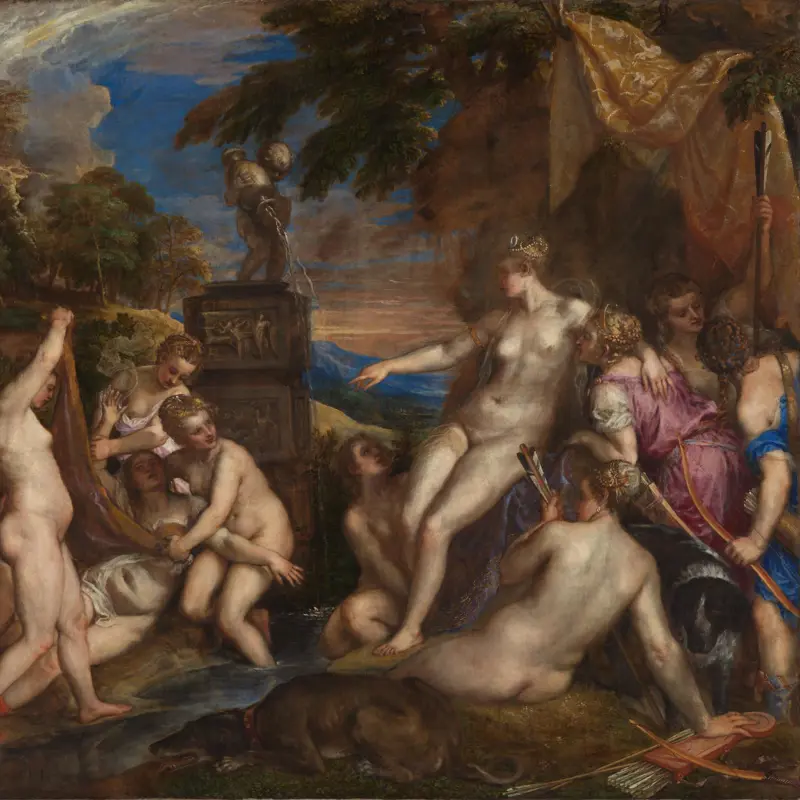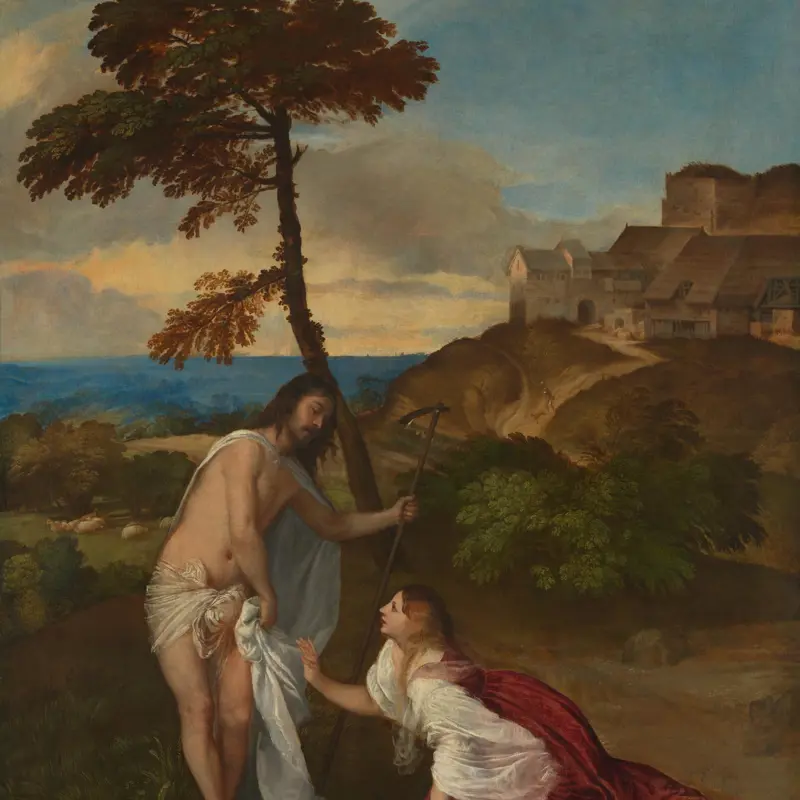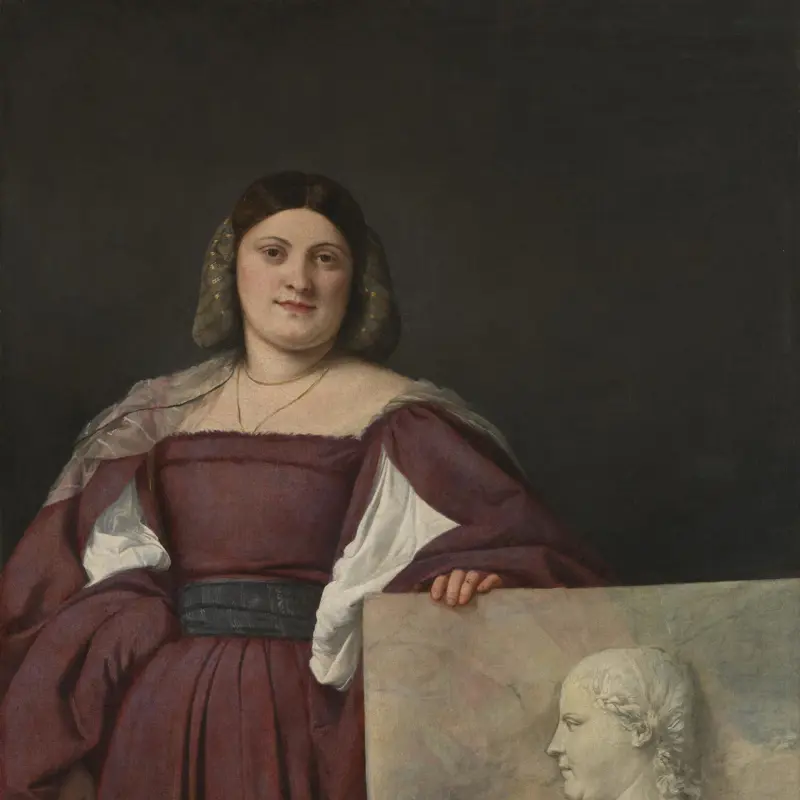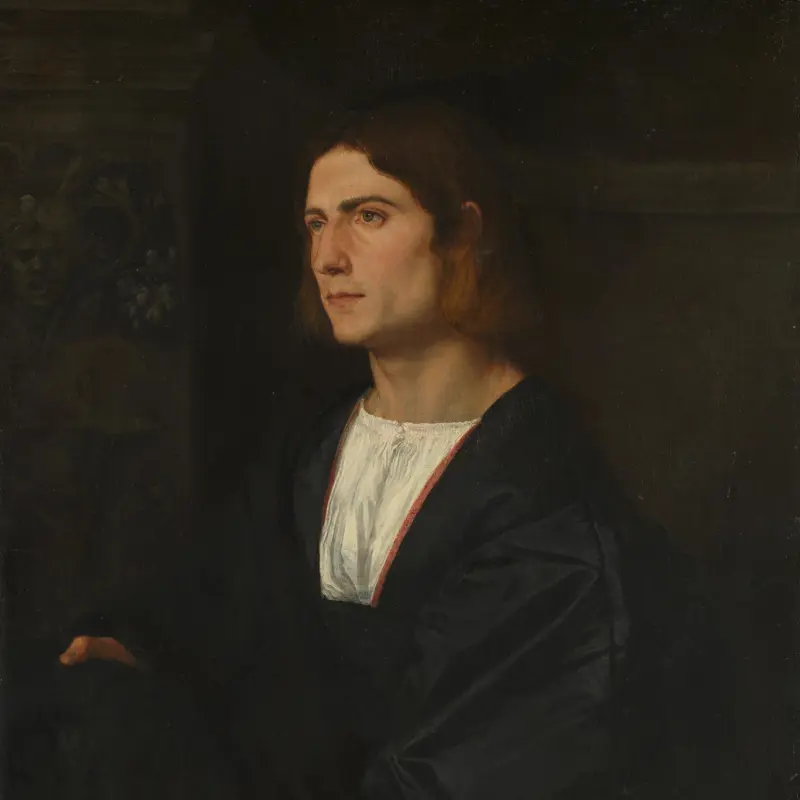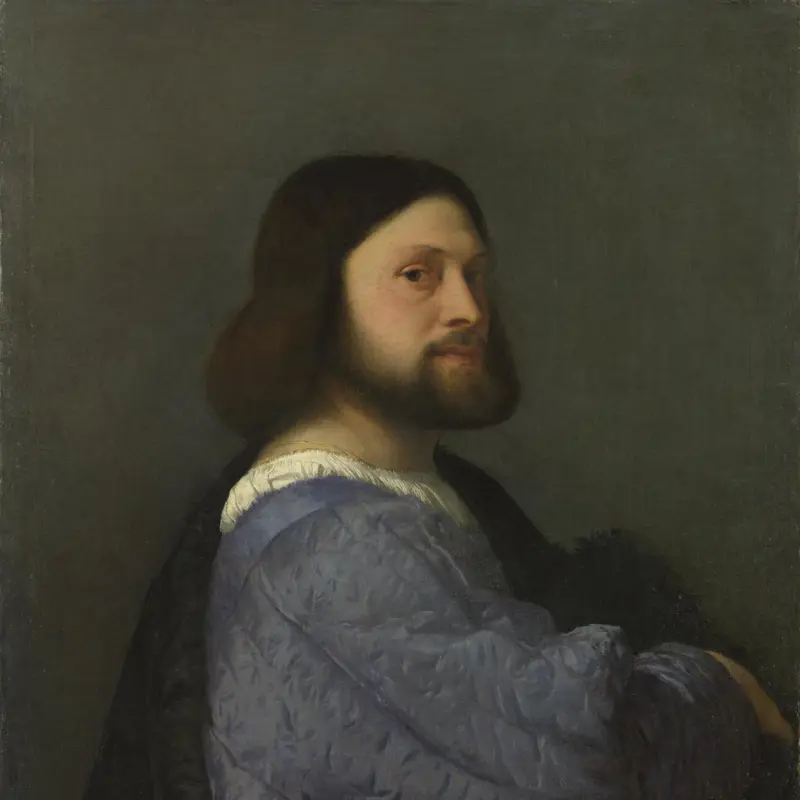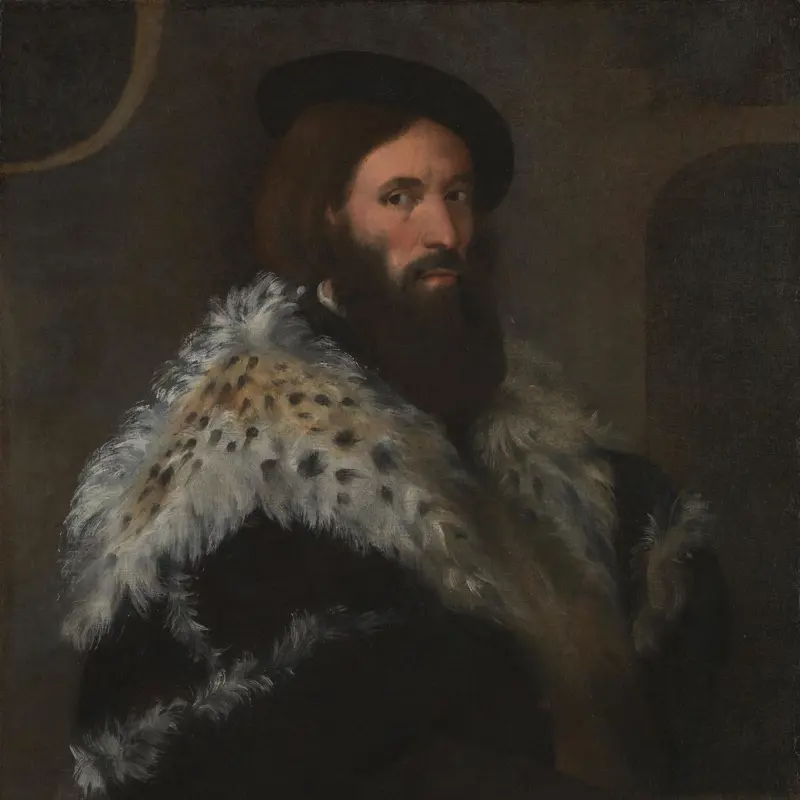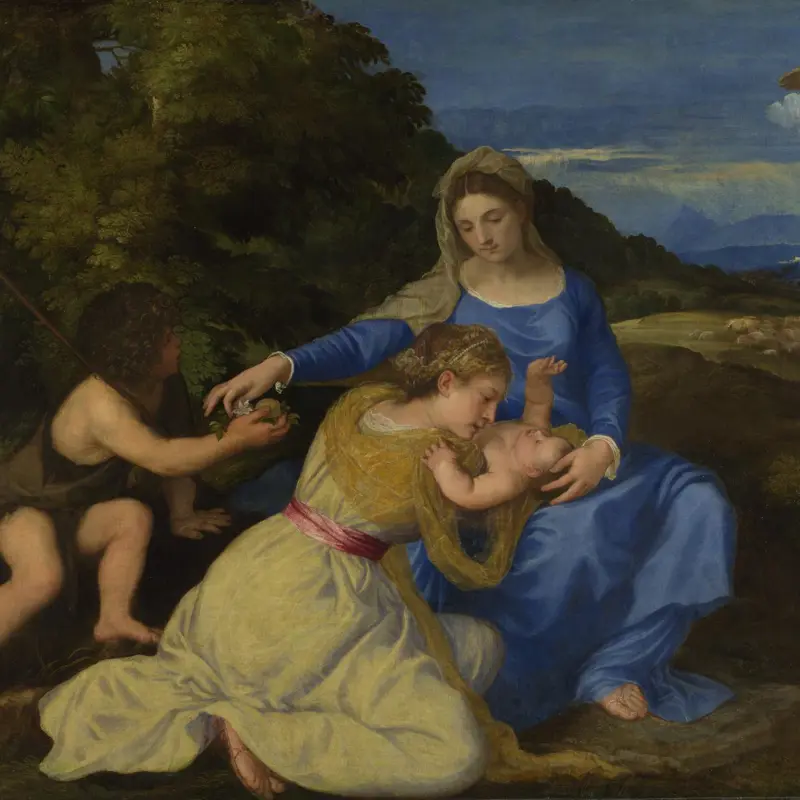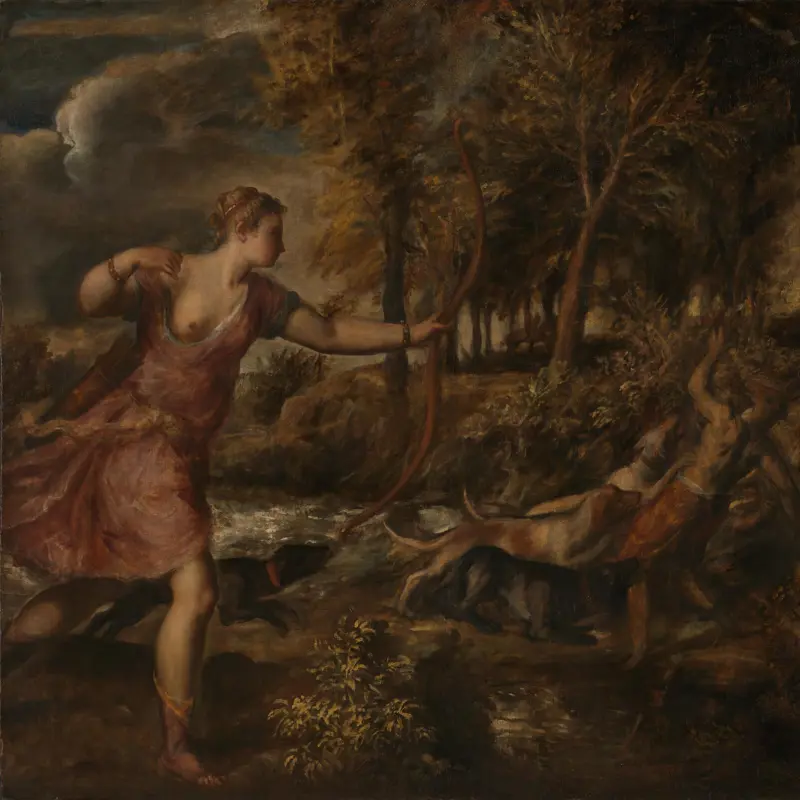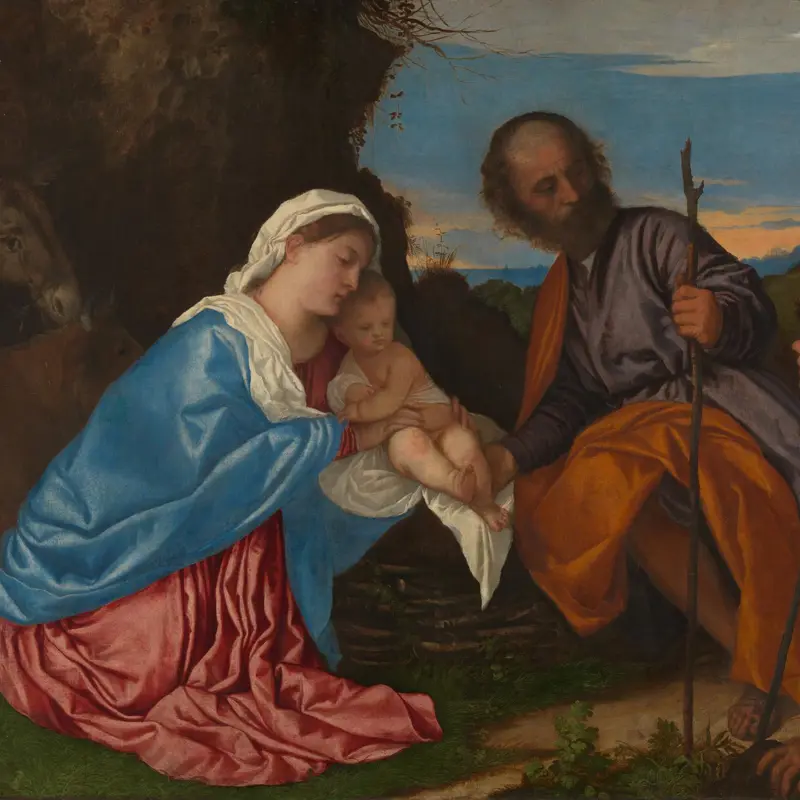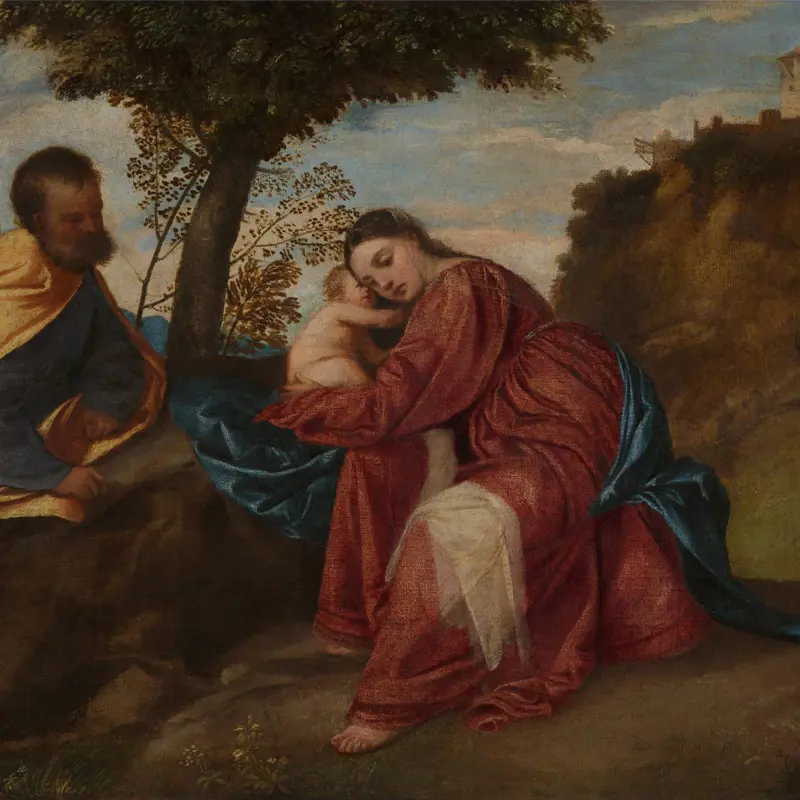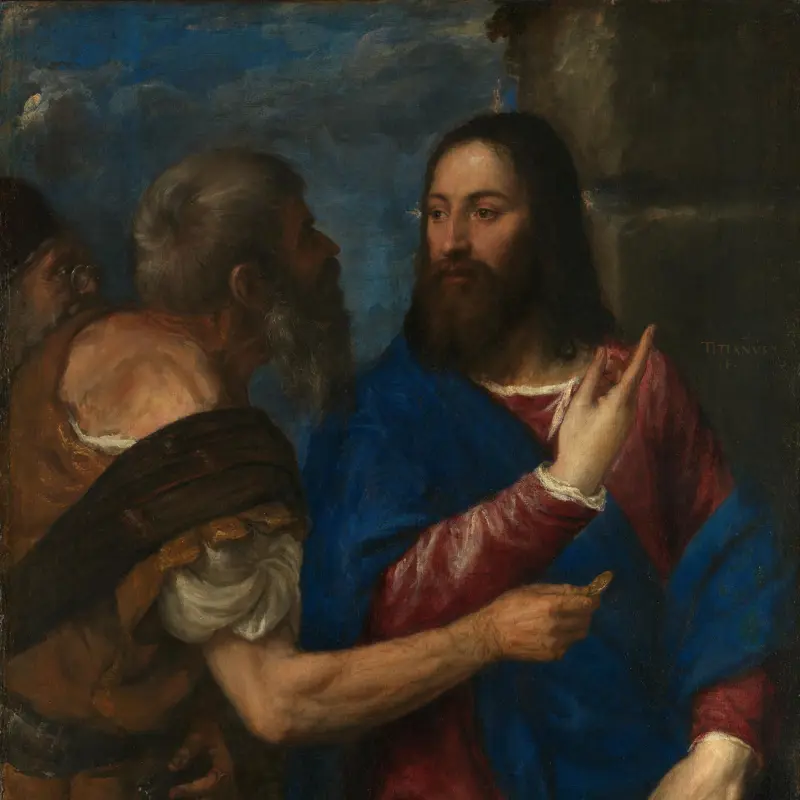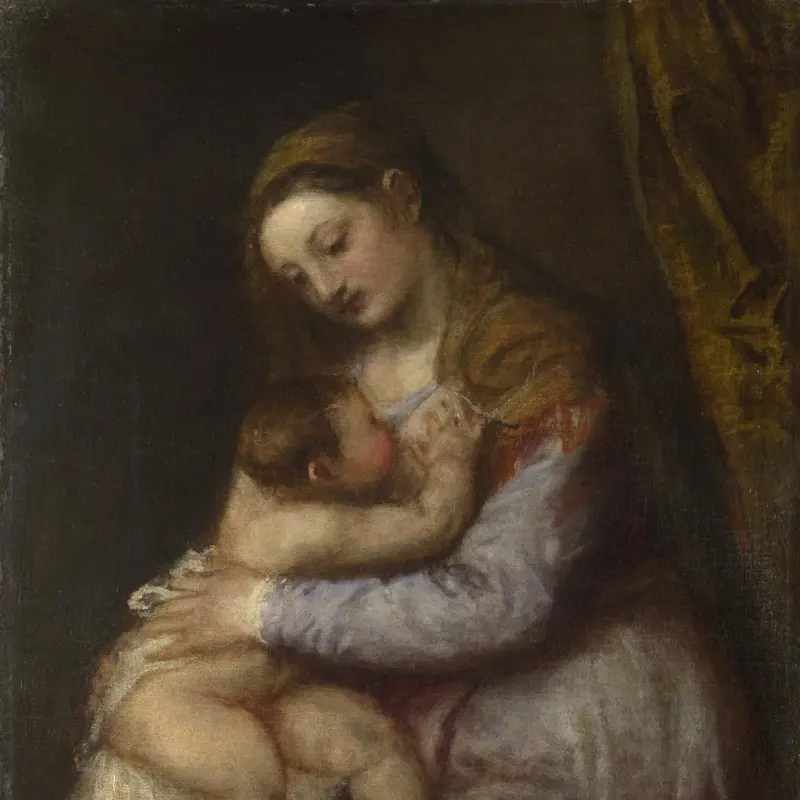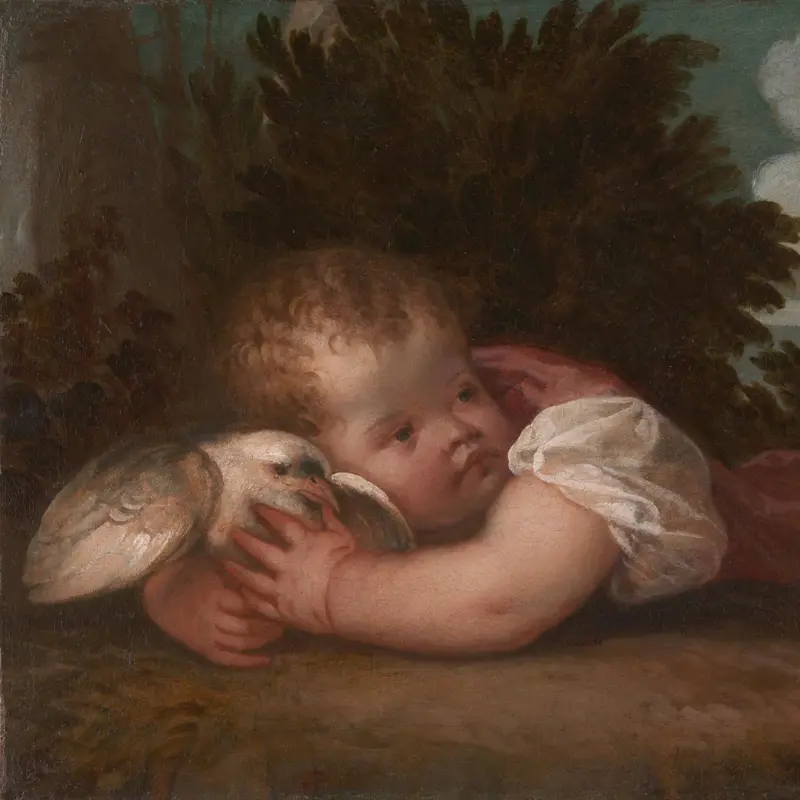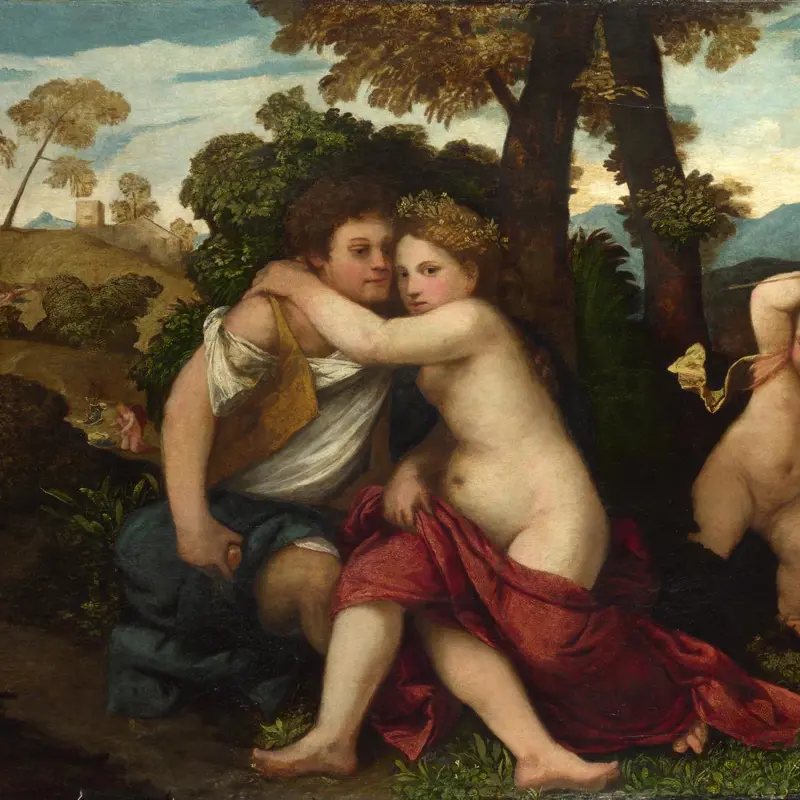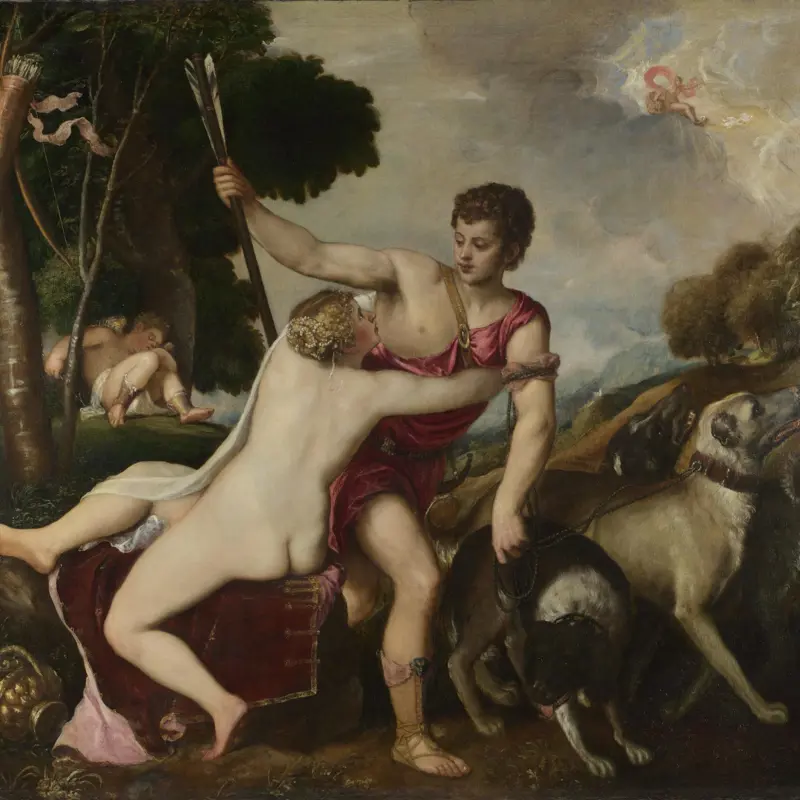Possibly by Titian, 'The Music Lesson', about 1535
About the work
Overview
A boy sings from a partbook while his music master beats time with his finger and perhaps sings along. A woman leans her arm against the teacher’s shoulder, her head tilted with a faraway look as if she is listening to the music. A youth accompanies the boy on a viol da gamba, while a young man behind him plays the recorder. The theme of music-making is often associated in art with lovemaking and the passing of time.
For many years The Music Lesson was believed to have been painted in the early 1600s by an artist imitating the style of Titian. Cleaning and technical examination revealed that the painting has much in common with pictures painted by Titian and his workshop in the 1530s.
This type of picture – a group of figures with the suggestion of a story or portraiture – was made popular by Giorgione, with whom Titian associated closely in his youth.
Key facts
Details
- Full title
- The Music Lesson
- Artist
- Possibly by Titian
- Artist dates
- active about 1506; died 1576
- Date made
- about 1535
- Medium and support
- oil on canvas
- Dimensions
- 99 × 120 cm
- Acquisition credit
- Bought, 1824
- Inventory number
- NG3
- Location
- Not on display
- Collection
- Main Collection
- Previous owners
Provenance
Purchased with the Angerstein collection, 1824. Recorded in that collection by 1806. The Gallery’s catalogues between 1915 and 1929 note that the painting is ‘perhaps from R. Strange coll., 1771’, but the ‘evidence for this’ eluded Cecil Gould.
The painting was in the Gonzaga collection by 1627, was acquired from that collection by King Charles I, and was then in his sale.
Burton Fredericksen points out that it is possible that NG 3 corresponds with lot 24 in the Pasquier sale of 10 March 1755 which is described as ‘Un Concert de Musique vocale’ performed by five half-length figures, including a woman with her hand on a man’s shoulder. The colour and ‘effet’ were said to be ‘admirable’ and the majority of connoisseurs considered it to be by Titian. It was on canvas and measured 36 by 46 pouces which is close to NG 3. It was bought by Boucault, ‘receveur de la ville’, for 853 livres.
Additional information
Text extracted from the ‘Provenance’ section of the catalogue entry in Nicholas Penny, ‘National Gallery Catalogues: The Sixteenth Century Italian Paintings’, vol. 2, ‘Venice 1540–1600’, London 2008; for further information, see the full catalogue entry.
Bibliography
-
1757A. van der Doort, A Catalogue and Description of King Charles the First's Capital Collection of Pictures, Limnings, Statues, Bronzes, Medals, and Other Curiosities: Now Published from an Original Manuscript in the Ashmolean Museum at Oxford, the Whole Transcribed…by the Late Ingenious Mr Vertue, ed. G. Vertue, London 1757
-
1823J. Young, A Catalogue of the Celebrated Collection of Pictures of the Late John Julius Angerstein, Esq: Containing a Finished Etching of Every Picture, and Accompanied with Historical and Biographical Notices, London 1823
-
1824P.G. Patmore, British Galleries of Art, London 1824
-
1832W.Y. Ottley, A Descriptive Catalogue of the Pictures in the National Gallery, London 1832
-
1834J. Landseer, A Descriptive, Explanatory, and Critical Catalogue of Fifty of the Earliest Pictures Contained in the National Gallery of Great Britain, London 1834
-
1877J.A. Crowe and G.B. Cavalcaselle, Titian: His Life and Times, London 1877
-
1889National Gallery, Descriptive and Historical Catalogue of the Pictures in the National Gallery with Biographical Notices of the Painters: Foreign Schools, London 1889
-
1901E. Jacobsen, 'Italienische Gemälde in der National Galerie zu London: Kritische Notizen zum Katalog von 1898', Repertorium für Kunstwissenschaft, XXIV, 1901
-
1913A. Luzio, La galleria dei Gonzaga venduta all'Inghilterra nel 1627-28: Documenti degli archivi di Mantova e Londra, Milan 1913
-
1924W.G. Constable, 'The Foundation of the National Gallery', The Burlington Magazine, XLIV/253, 1924, pp. 158-72
-
1929National Gallery, National Gallery, Trafalgar Square: Catalogue, 86th edn, London 1929
-
1932B. Berenson, Italian Pictures of the Renaissance: A List of the Principal Artists and Their Works, with an Index of Places, Oxford 1932
-
1935W. Suida, Le Titien, Paris 1935
-
1950D. Mahon, 'Notes on the "Dutch Gift" to Charles II: III', The Burlington Magazine, XCII/562, 1950, pp. 12-8
-
1958O. Millar, 'Abraham van Der Doort's Catalogue of the Collections of Charles I', The Walpole Society, XXXVII, 1960, pp. 1-249
-
1959Gould, Cecil, National Gallery Catalogues: The Sixteenth Century Venetian School, London 1959
-
1972B.W. Meijer, 'Niccolo Frangipane', Saggi et memorie di storia dell'arte, VIII, 1972, pp. 255-78
-
1975C. Gould, Delaroche and Gautier: Gautier's Views on the 'Execution of Lady Jane Grey' and on other Compositions by Delaroche, London 1975
-
1987Gould, Cecil, National Gallery Catalogues: The Sixteenth Century Italian Schools, London 1987
-
1993U. Ruggeri, 'Due nuovi disegni di Tiziano', in J. Manca (ed.), Titian 500, Washington 1993, vol. 45, pp. 85-99
-
1997S. Rinaldi, 'Il primo restauro seicentesco della collezione Gonzaga venduta a Carlo I d'Inghilterra" Stefano Marconi and Marisa Dalai Emilianis', in S. Marconi and M. Dalai Emiliani (eds), Scritti e immagini in onore di Corrado Maltese, Rome 1997, pp. 259-70
-
1998K. Bott, '"Nur originalia von einem berühmten guten maister": Kopie oder Original in der Kunstsammlung der Grafen von Schönborn', Städel-Jahrbuch, XVI, 1998, pp. 257-88
-
2001
C. Baker and T. Henry, The National Gallery: Complete Illustrated Catalogue, London 2001
-
2002R. Morselli, Gonzaga: La celeste galeria (exh. cat. Museo di Palazzo Ducale (Mantua), 2 September - 8 December 2002), Milan 2002
-
2008Penny, Nicholas, National Gallery Catalogues: The Sixteenth Century Italian Paintings, 2, Venice, 1540-1600, London 2008
About this record
If you know more about this work or have spotted an error, please contact us. Please note that exhibition histories are listed from 2009 onwards. Bibliographies may not be complete; more comprehensive information is available in the National Gallery Library.

